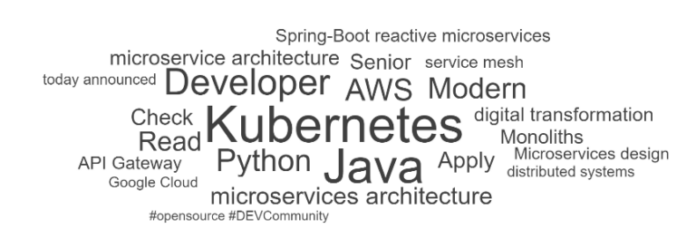This post originally appeared on the FINOS blog. You can also listen to the latest FINOS podcast with Minesh Patel, Chief Technology Officer at REGnosys, discussing his upcoming talk at the FINOS Open Source in Finance Forum (OSFF) on July 13th in London about “Breaking new ground in RegTech through open source TechSprint innovation”.
In the first quarter of 2022, a multi-organisation, multi-location team of developers planned, scheduled and delivered an ambitious three day “RegTech” collaboration challenge.
The event, dubbed a “TechSprint”, looked to demonstrate how financial institutions could comply with trade reporting rules for the upcoming US CFTC requirements using entirely open-source components.
Why It’s Important
Every year, the financial industry spends billions trying to comply with often complex data reporting requirements. For every reporting regime and jurisdiction, firms must typically sift through hundreds of pages of legal text, which they must then manually interpret and code in their IT systems.
As a result, while many financial institutions share the same reporting obligations, they usually implement their logic in slightly different ways due to fragmented technology approaches, adding to risks and costs.
The field is ripe for a shake-up by “RegTech”, i.e. the application of technology to address regulatory challenges. In particular, the ability to build and store the reporting logic in an open-source and technology-agnostic way, and to run it based on open-source components too, could reap huge efficiency benefits for the industry.
Current Landscape
This RegTech space is one that FINOS has been actively investing in. In 2020, FINOS approved the contribution of the Regulation Innovation SIG, a Special Interest Group dedicated to the applications of open source to regulatory problems. Morphir, an open-source project contributed by Morgan Stanley, is positioned as a key component of that Reg SIG. Morphir allows to represent, store, share and process business logic in an implementation-agnostic way, including the types of rules and calculations often found in regulations.
The industry is also getting better organised to tackle pressing regulatory challenges more collaboratively. Under the auspices of the industry’s existing trade associations, the Digital Regulatory Reporting (DRR) programme is a mutualized, industry-wide initiative addressing the global trade reporting requirements. Those reporting regimes are being updated across the G20 and DRR starts with the US CFTC revised swap data reporting rules that go live this year. DRR involves industry participants working together to deliver an open-source, machine-executable expression of the reporting rules.
These two initiatives, Morphir and DRR, looked like a perfect match. A like-minded team of developers sitting across organisations decided to undertake the challenge of integrating them, thus demonstrating that reporting rules can be developed, executed and validated using entirely open-source components – all under three days!
Approach
Technical
In DRR, the rule logic is expressed in a Domain-Specific Language called the Rosetta DSL and then translated into executable code through an automated “code generation” process. The reporting rules’ inputs are modelled according to the Common Domain Model (CDM), an initiative initially championed by the International Swaps and Derivatives Association (ISDA), now joined by other trade associations, and involving many industry participants including buy- and sell-side firms.
The Rosetta DSL and its associated code generators, currently being proposed for contribution to FINOS, are open-source projects developed by technology firm REGnosys, which provides the software platform for the DRR and CDM programme.
The main objective of the TechSprint was to develop a Rosetta-to-Morphir code generator. This would demonstrate that Morphir can be used as a target for storing and executing the body of rules in DRR and that it produces results that are consistent with Rosetta. In addition, the TechSprint looked to provide a formal verification mechanism for the DRR code using Bosque, another open-source project developed by Microsoft that is already integrated with Morphir.
Scope
The first trade reporting regime available in DRR is the CFTC Rewrite, which is rolling out in the US this year. The TechSprint focused on handling a couple of CFTC reportable fields to demonstrate the Rosetta-Morphir-Bosque integration.
Logistics
Building on our proven approach seen over the last two years with the Legend pilot and the Legend hosted instance, the event was run as a “task-force” where teams sitting across organisations’ boundaries collaborated and shared knowledge on their respective open-source projects, all under FINOS’s sponsorship.
In total, seven representatives from three teams at Morgan Stanley, Microsoft and REGnosys have worked together for three days across three separate locations in the UK, Ghana and the US.
Given the time zone differences, the TechSprint was held virtually, starting with the UK/Ghana shift and closing with the NY shift. The teams were mostly self-organised, with regular checkpoints throughout the day.
Substantial Results at Record Speed
In just three days, a Rosetta-to-Morphir code generator has been developed successfully. Whilst not complete, it has been shown to handle increasingly complex logic from Rosetta. REGnosys is integrating this deliverable back into Rosetta’s main open-source code-base.
A couple of in-scope reportable fields were successfully tested by running the Morphir-Scala engine on a sample trade population and displayed in a UI, matching their expected results in Rosetta. The Morphir UI showed how the reporting logic stored in Morphir could be represented graphically.
Finally, the Bosque validation layer was successfully applied to the code generated from Rosetta, opening the way to a formal verification method for the rules developed in DRR.
Take-Aways and Next Steps
One of the most interesting take-aways from this TechSprint event was its task-force format, which allowed the teams to perform at their level best. This format could serve as a template for future “open innovation” initiatives engaging the FINOS community.
The key ingredients of success were:
A specific and tangible deliverable
Collaboration, not competition, on that shared objective
Diversity of participants, all goal-oriented
Clear responsibilities of the different team members
Careful preparation and planning
A “safe space” to contribute in open-source
As a next step, the TechSprint team will be demonstrating the result of their work at the upcoming Open Source in Finance Forum in London (July 13th). Those results will be encapsulated into a video that will be made publicly available.
The Morphir-to-Rosetta code generator delivered during the TechSprint is also included in a formal open-source contribution to FINOS. This will create a first bridge between the on-going DRR industry programme and the wider FINOS community, allowing to connect it to similar initiatives taking place under the Reg SIG.
Given interest and community engagement in that group, further open innovation events involving multiple firms could be run along a similar format.
The potential benefits of open collaboration in the regulatory space are massive. This TechSprint demonstrates how new ground can be broken when barriers tumble down.
Authors:
Leo Labeis, Founder and CEO at REGnosys
Stephen Goldbaum, Executive Director at Morgan Stanley
Mark Marron, Principal Research Software Development Engineer at Microsoft
The post Morgan Stanley, Microsoft, and Regnosys Break New Ground in RegTech with FINOS appeared first on Linux Foundation.



